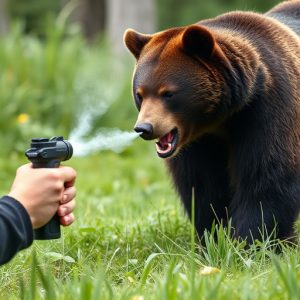Wilderness Survival: Bear Attack Protection Strategies & Spray Effectiveness
Bears exhibit unpredictable behavior, so maintaining a safe distance is crucial for wilderness survi…….
Bears exhibit unpredictable behavior, so maintaining a safe distance is crucial for wilderness survival. The recommended 20-30 feet (6-9 meters) is optimal for bear spray effectiveness, temporarily blinding and disorienting bears. Correct usage involves following instructions and aiming at the bear's face during an attack. Staying at least 100 yards (91 meters) away from bears reduces threats. Combining these practices substantially enhances safety in bear country.
In the vast wilderness, understanding bear behavior is key to your survival. This article equips you with essential knowledge to navigate potential risks and protect yourself from bear attacks. We delve into the science behind bear spray, its effectiveness, and proper usage techniques. Additionally, discover strategic methods to maintain safe distances and prevent encounters. Learn the best practices for minimizing your risk while exploring bear country, including the optimal distance for maximizing bear spray effectiveness.
- Understanding Bear Behavior and Attack Patterns
- The Science Behind Bear Spray: Effectiveness and Usage
- Strategies for Maintaining Safe Distances and Preventing Attacks
Understanding Bear Behavior and Attack Patterns
Bears, whether black or grizzly, are powerful animals with complex behaviors that can be unpredictable at times. Understanding their habits and attack patterns is a crucial step in ensuring wilderness survival. It’s essential to know that bears typically avoid humans unless they perceive a threat, food source, or feel their cubs are in danger. However, when provoked or surprised, they may charge, resulting in an attack.
In terms of protection, maintaining the recommended distance for bear spray effectiveness is vital. The optimal range is around 20-30 feet (6-9 meters), where the spray can effectively deter a bear without causing severe harm. This distance allows you to deploy the spray and create a barrier between you and the bear, providing crucial seconds to escape or find shelter if needed. Remember, awareness of local regulations regarding bear spray use is also important for responsible wilderness survival practices.
The Science Behind Bear Spray: Effectiveness and Usage
Bear spray, also known as bear repellent, has become an essential tool in wilderness survival. The science behind its effectiveness lies in the active ingredients that create a barrier between you and the bear. When used properly, bear spray can deter aggressive bears by irritating their eyes, nose, and throat, temporarily disorienting them.
The best distance for bear spray effectiveness is generally considered to be around 20-30 feet (6-9 meters). At this range, the spray can cover your body and create a protective barrier. It’s crucial to follow the instructions on the label and aim for the bear’s face if an attack seems imminent. While not guaranteed to stop every attack, bear spray significantly increases your chances of escaping unharmed when used in conjunction with other survival techniques like making noise and maintaining space.
Strategies for Maintaining Safe Distances and Preventing Attacks
When venturing into bear country, maintaining a safe distance is paramount. The best strategy to prevent a bear attack is to keep a reasonable distance from bears at all times. Generally, it’s recommended to stay at least 100 yards (91 meters) away from bears in most cases. This distance ensures that the bear doesn’t feel threatened and has enough space to retreat or communicate without aggression.
For added protection, when using bear spray as a deterrent, be mindful of its effectiveness at different distances. Bear spray is most effective up close, typically within 20-30 feet (6-9 meters). This range allows the spray to reach the bear’s eyes and nose, temporarily blinding and disorienting it. However, spraying from a greater distance may not provide the same level of protection, as bears can still detect and react to the scent. Therefore, staying within this ideal range for both prevention and effective spray use is crucial for bear attack protection.
In conclusion, understanding bear behavior, knowing the science behind bear spray, and implementing strategies to maintain safe distances are key components of wilderness survival in areas frequented by bears. By adhering to best practices, such as staying within recommended bear spray effectiveness ranges (like 20-30 meters) and avoiding close encounters, individuals can significantly reduce the risk of bear attacks and enjoy their outdoor adventures with greater peace of mind.


